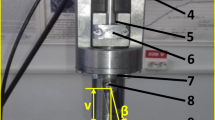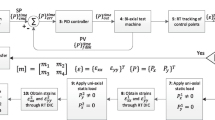Abstract
Methods of achieving biaxial-stress states in fatigue tests are reviewed. A new design of equipment that produces five distinct biaxial-stress states by simultaneous direct pressurization and axial loading of thinwalled cylindrical specimens is described. Four variations of stress state are obtained by the use of two sizes of specimen and by reversal of the pressurizing connections. The fifth state is obtained by direct pressurization without axial load. The actual magnitudes of stress in the specimen are computed from the output of the load cell in the reaction frame in which the biaxial-testing device is mounted. Additional stress ratios are obtained using standard uniaxial and torsional cyclic-testing arrangements.
The initial program using this equipment was to investigate the effects of biaxiality on the cyclic properties and low-cycle fatigue behavior of normalized 1018 mild steel, under fully reversed constant-amplitude strain control. Control was achieved using a servo-controlled, electrohydraulic testing system with one of the two clipon strain transducers, that were mounted on the specimen, providing the controlling electrical signal. The system allowed direct recording of the stress-strain hysteresis loops in both principal directions. The behavior of the equipment and the modes of failure of the specimens are described and some test data are presented. The range of application and limitations of the equipment for further cyclic biaxial testing are discussed.
Similar content being viewed by others
References
Smith, J. O., “The Effect of Range of Stress on the Fatigue Strengt of Metals,” Univ. of Illinois, Engineering Experiment Stations, Bulletin No. 334 (Feb. 17, 1942).
Chodorowski, W. T., “Fatigue Strength in Shear of an Alloy Steel,” Proc. Intl. Conf. on Fatigue of Metals. London-New York, 122–131 (1956).
Kennedy, C. R., “Effect of Stress State on Low-Cycle Fatigue,” ASTM STP-338, Symp. on Fatigue of Aircraft Struct., 92–104 (1962).
Halford, G. R. andMorrow, JoDean, “Low-Cycle Fatigue in Torsion,”Proc. ASTM,62,695–709 (1962).
Gough, H. J., “Engineering Steels under Combined Static and Cyclic Stresses,”Jnl. Appl. Mech.,17 (2),113–125 (1950).
Findley, W. N., “Fatigue of 76S-T61 Aluminum Alloy under Combined Bending and Torsion,”Proc. ASTM,52,818–832 (1952).
Findley, W. N., “Fatigue of Metals under Combinations of Stresses,”Trans. ASME,79,1337–1348 (1957).
Ros, M. and Eichinger, A., “Die Bruchgefahr fester Korper bie Wiederholten Beanspruchung-Ermundung,” EMPA Bulletin,173,Zurich (1950).
Bundy, R. W. andMarin, J., “Fatigue Strength of 14S-T4 Aluminum Alloy Subjected to Biaxial Stresses,”Proc. ASTM,54,755–766 (1954).
Marin, J., “Biaxial Tension-tension Fatigue Strengths of Metals,”Jnl. Appl. Mech.,16,383–388 (1949).
Majors, H., Jr., Mills, B. D., Jr. andMacGregor, C. W., “Fatigue under Combined Pulsating Stresses,”Jnl. Appl. Mech.,16,269–276 (1949).
Sawert, W., “Verhalten der Baustachle bei Wechselnder Mehrachsiger Beanspruchung,”Z. Deut. Ing.,87, (39/40),609–615 (1943).
Bowman, C. E. andDolan, T. J., “Studies of the Biaxial Fatigue Properties of Pressure Vessel Steels,”Welding Jnl. Res. Suppl.34 (1),51s-59s (1955).
Bowman, C. E. andDolan, T. J., “Biaxial Fatigue Properties of Pressure Vessel Steels,”Welding Jnl. Res. Suppl.,32 (11),529s-537s (1953).
Ives, K. D., Kooistra, L. F. and Tucker, J. T., Jr, “Equibiaxial Low-Cycle Fatigue Properties of Typical Pressure Vessel Steels,” ASME Paper 65-MET-19.
Shewchuk, J., Zamrik, S. Y., andMarin, J., “Low-cycle Fatigue of 7075-T651 Aluminum Alloy in Biaxial Bending,”Experimental Mechanics,8 (11),504–512 (1968).
Gross, J. H., Tsang, S. andStout, R. D., “Factors Affecting Resistance of Pressure Vessel Steels to Repeated Loading,”Welding Jnl. Res. Suppl.,32 (1),23s-30s (1953).
Gross, J. H., Gucer, D. E. andStout, R. D., “The Plastic Fatigue Strength of Pressure Vessel Steels,”Welding Jnl. Res. Suppl. 33, (1),31s-39s (1954).
Stout, R. D. and Pense, A. W., “Effect of Composition and Microstructure on the Low-Cycle Fatigue Strength of Structural Steels,” Jnl. Basic Eng., 269–274 (June 1965).
Pascoe, K. J. andde Villiers, J. W. R., “Low-Cycle Fatigue of Steels under Biaxial Straining,”Jnl. Strain Anal.,2 (2),117–126 (1967).
McLaren, S. W. and Terry, E. L., “Characteristics of Aerospace Materials Subjected to Biaxial Static and Fatigue Loading Conditions,” ASME Paper 63-WA-315.
McLaren, S. W. and Best, J. H., “Plastic Strain Accumulation—New Fatigue Life Forecaster?,“ SAE Jnl., 68–75 (Sept. 1965).
Author information
Authors and Affiliations
Additional information
The research for this paper was supported in part by the Defence Research Board of Canada, Grant Number 9535-49 and the National Research Council of Canada, Grant Number A 1694.
Rights and permissions
About this article
Cite this article
Havard, D.G., Topper, T.H. New equipment for cyclic biaxial testing. Experimental Mechanics 9, 550–557 (1969). https://doi.org/10.1007/BF02316657
Issue Date:
DOI: https://doi.org/10.1007/BF02316657




